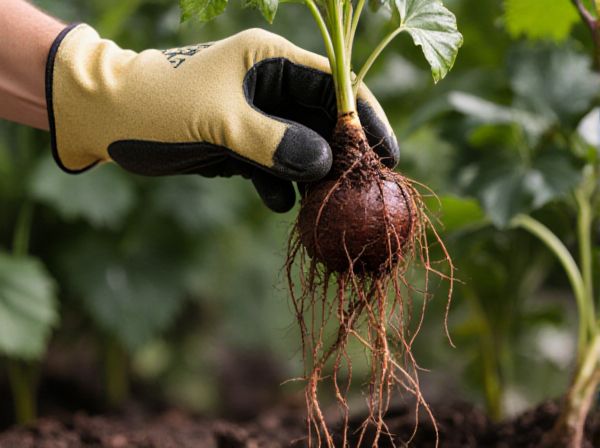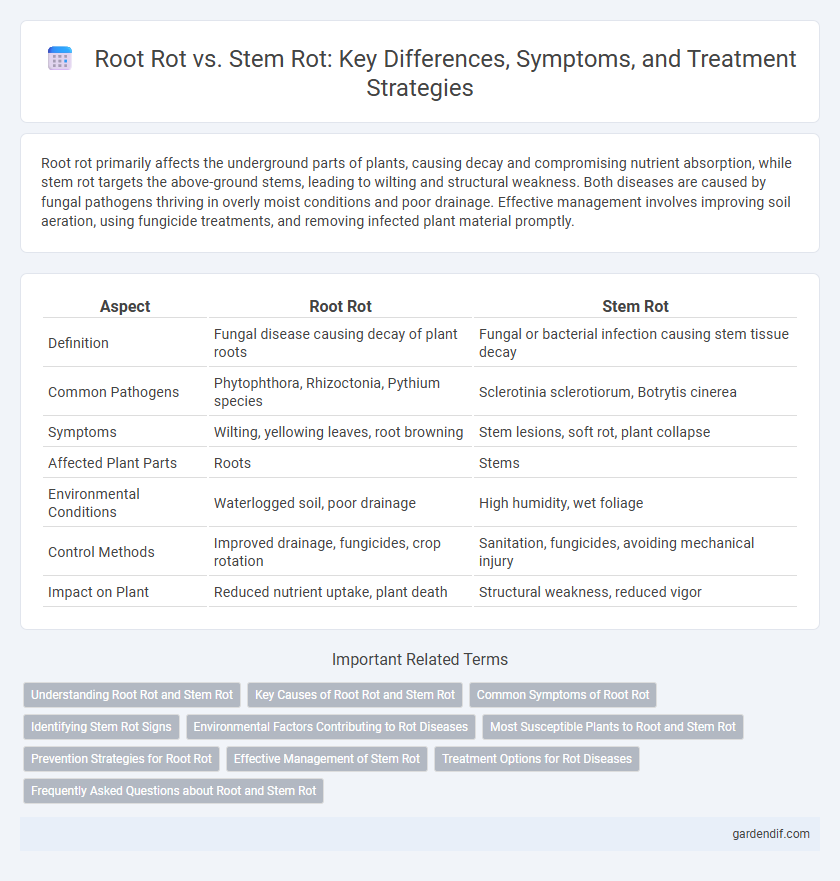
Root rot vs Stem rot Illustration
Root rot primarily affects the underground parts of plants, causing decay and compromising nutrient absorption, while stem rot targets the above-ground stems, leading to wilting and structural weakness. Both diseases are caused by fungal pathogens thriving in overly moist conditions and poor drainage. Effective management involves improving soil aeration, using fungicide treatments, and removing infected plant material promptly.
Table of Comparison
| Aspect | Root Rot | Stem Rot |
|---|---|---|
| Definition | Fungal disease causing decay of plant roots | Fungal or bacterial infection causing stem tissue decay |
| Common Pathogens | Phytophthora, Rhizoctonia, Pythium species | Sclerotinia sclerotiorum, Botrytis cinerea |
| Symptoms | Wilting, yellowing leaves, root browning | Stem lesions, soft rot, plant collapse |
| Affected Plant Parts | Roots | Stems |
| Environmental Conditions | Waterlogged soil, poor drainage | High humidity, wet foliage |
| Control Methods | Improved drainage, fungicides, crop rotation | Sanitation, fungicides, avoiding mechanical injury |
| Impact on Plant | Reduced nutrient uptake, plant death | Structural weakness, reduced vigor |
Understanding Root Rot and Stem Rot
Root rot and stem rot are fungal diseases that severely affect plant health by targeting different parts of the plant's vascular system; root rot primarily damages the roots, leading to poor nutrient uptake and wilting, while stem rot causes decay in the stem tissue, disrupting nutrient transport. Common pathogens include Fusarium, Phytophthora, and Rhizoctonia species, thriving in overly wet or poorly drained soils which facilitate fungal proliferation. Effective management involves improving soil drainage, applying fungicides, and selecting resistant plant varieties to prevent extensive crop loss.
Key Causes of Root Rot and Stem Rot
Root rot is primarily caused by soil-borne fungi such as Phytophthora, Pythium, and Fusarium species thriving in poorly drained, waterlogged soils that suffocate plant roots. Stem rot results from fungal pathogens like Sclerotinia sclerotiorum and Rhizoctonia solani attacking plant stems, often facilitated by high humidity and mechanical injuries. Both diseases disrupt nutrient transport but originate in different plant tissues due to varying environmental triggers and pathogen types.
Common Symptoms of Root Rot
Root rot primarily causes symptoms such as wilting, yellowing leaves, and stunted growth due to impaired water and nutrient uptake from decayed roots. The affected roots often appear dark, mushy, and foul-smelling, distinguishing this condition from other plant diseases. Severe cases lead to plant death as the root system collapses and fails to support the above-ground tissues.
Identifying Stem Rot Signs
Stem rot manifests as dark, water-soaked lesions on the stem near the soil line, often accompanied by softening and eventual collapse of the stem tissue. Unlike root rot, which primarily affects the underground root system causing roots to become brown and mushy, stem rot symptoms are evident on the stem surface and can lead to wilting and plant death if left untreated. Early identification of stem rot signs such as discoloration and stem girdling is crucial for effective disease management and preventing spread.
Environmental Factors Contributing to Rot Diseases
Excessive soil moisture and poor drainage create anaerobic conditions that favor root rot pathogens like Phytophthora and Pythium. High humidity and warm temperatures promote stem rot caused by fungi such as Sclerotinia and Botrytis. Soil compaction and nutrient imbalance further exacerbate susceptibility to both root and stem rot diseases by weakening plant defenses.
Most Susceptible Plants to Root and Stem Rot
Root rot predominantly affects plants with poorly drained soils, including legumes, cucurbits, and ornamental shrubs such as azaleas and rhododendrons. Stem rot is more common in solanaceous crops like tomatoes, eggplants, and peppers, as well as in beans and certain fruit trees. Both diseases thrive in conditions of high humidity and soil moisture, increasing susceptibility across a variety of horticultural and agricultural plants.
Prevention Strategies for Root Rot
Effective prevention strategies for root rot include ensuring proper soil drainage and avoiding overwatering, which significantly reduce fungal growth in the root zone. Applying organic mulch and practicing crop rotation help maintain soil health and prevent the accumulation of root rot pathogens. Using disease-resistant plant varieties further strengthens plant defenses against common root rot fungi such as Phytophthora, Pythium, and Fusarium species.
Effective Management of Stem Rot
Effective management of stem rot involves timely fungicide application combined with proper crop rotation to reduce pathogen buildup in the soil. Ensuring adequate drainage and avoiding excessive irrigation minimizes the moist conditions that favor stem rot development. Regular monitoring and removal of infected plant debris further limit the spread and incidence of stem rot in affected crops.
Treatment Options for Rot Diseases
Effective treatment options for root rot and stem rot involve improving soil drainage and applying fungicides such as metalaxyl or phosphonates to inhibit pathogen growth. Removing infected plant material and practicing crop rotation reduces inoculum levels, while soil solarization can decrease pathogen populations. Biological control agents like Trichoderma spp. offer sustainable management by antagonizing rot-causing fungi in the rhizosphere.
Frequently Asked Questions about Root and Stem Rot
Root rot primarily affects the plant's root system, causing decay and hindering nutrient absorption, while stem rot targets the stem, leading to structural collapse and impaired nutrient transport. Common questions focus on symptom identification, environmental conditions encouraging each rot, and effective treatment options like fungicides and improved drainage. Understanding the distinct pathogens, such as Phytophthora spp. for root rot and Sclerotinia spp. for stem rot, aids in accurate diagnosis and prevention strategies.
Root rot vs Stem rot Infographic

 gardendif.com
gardendif.com